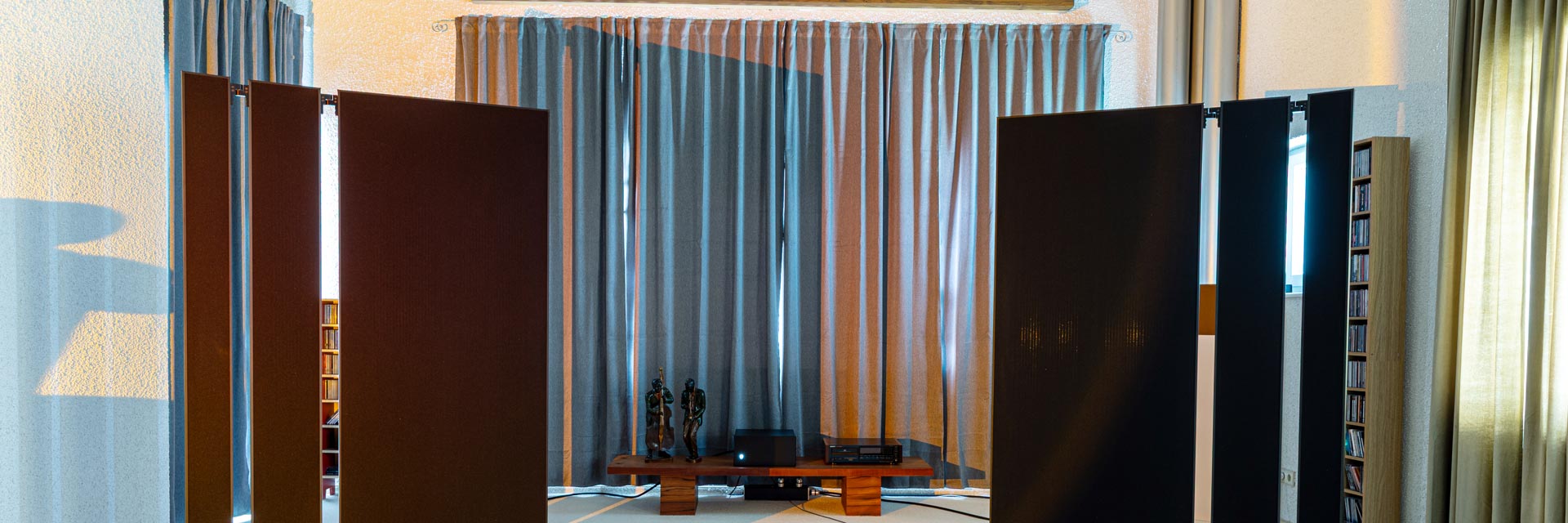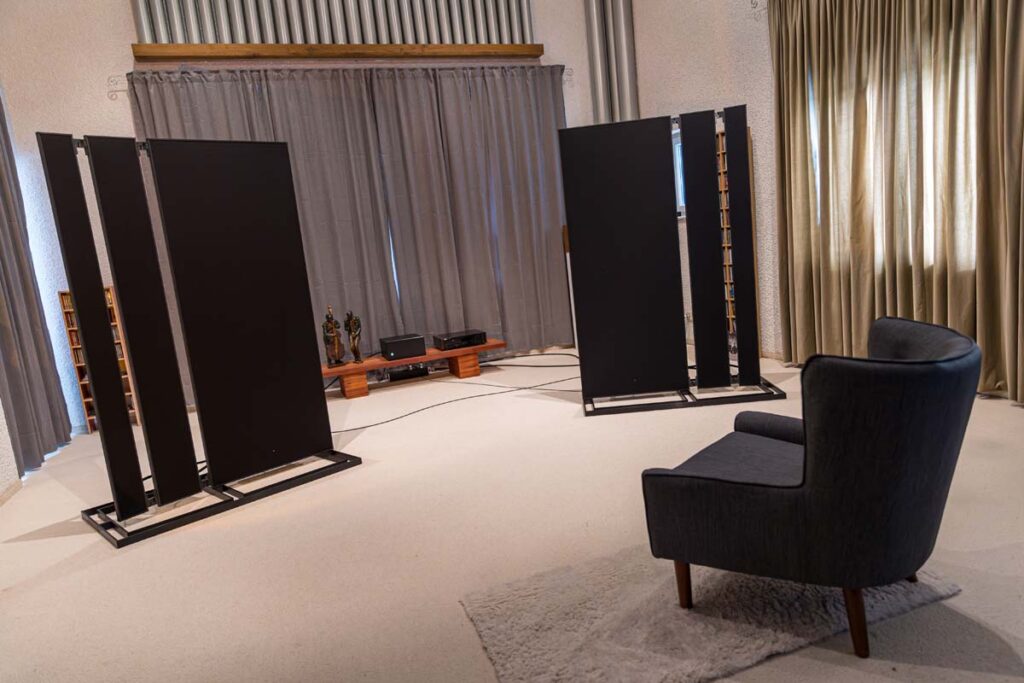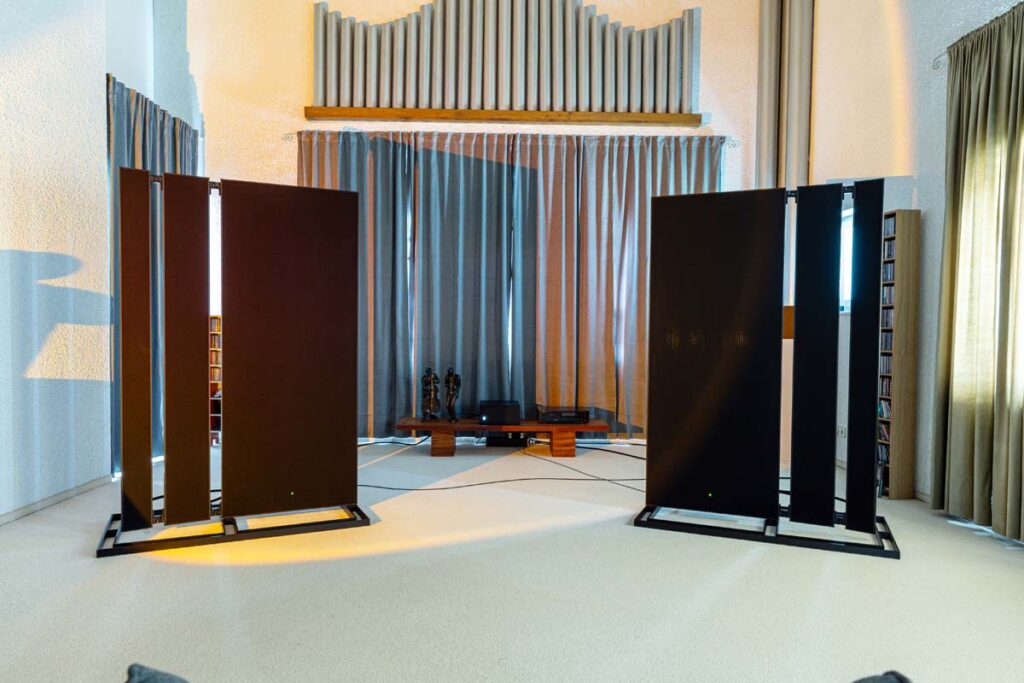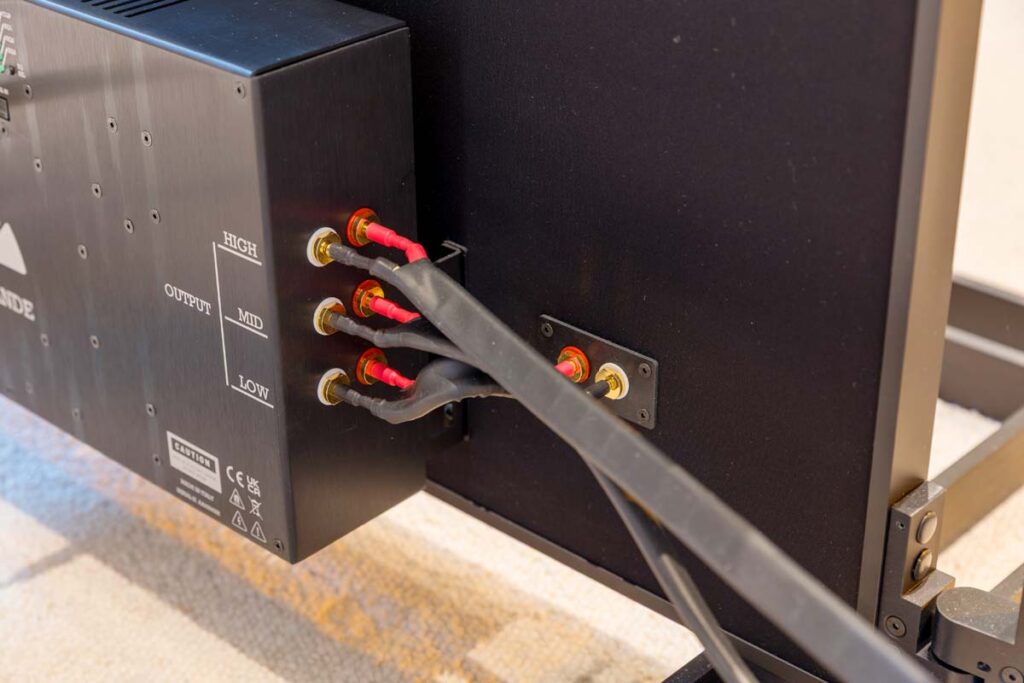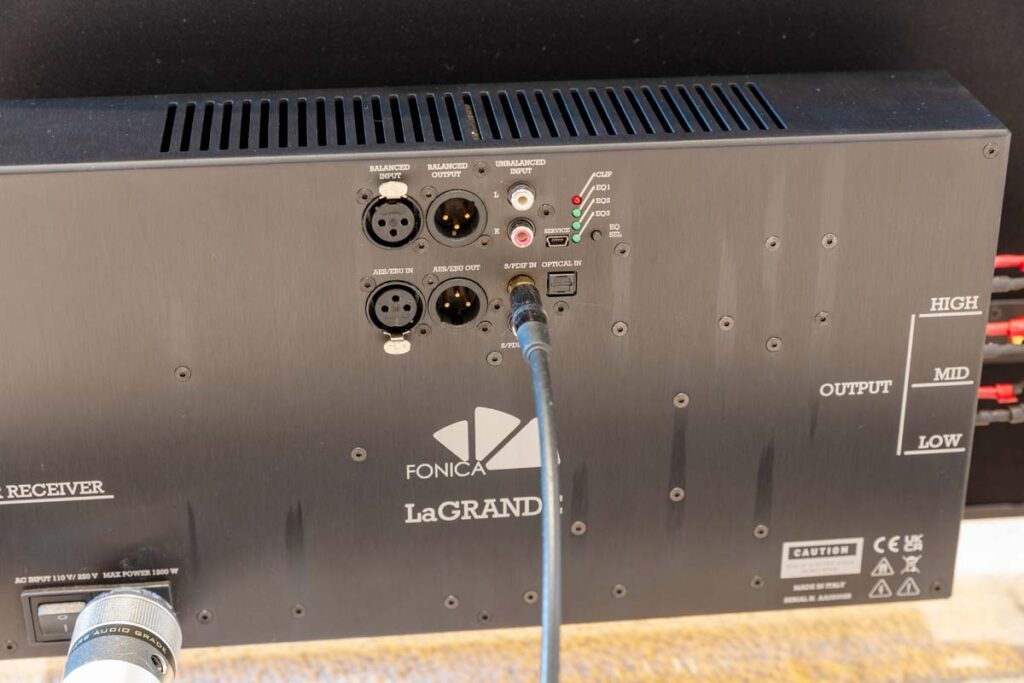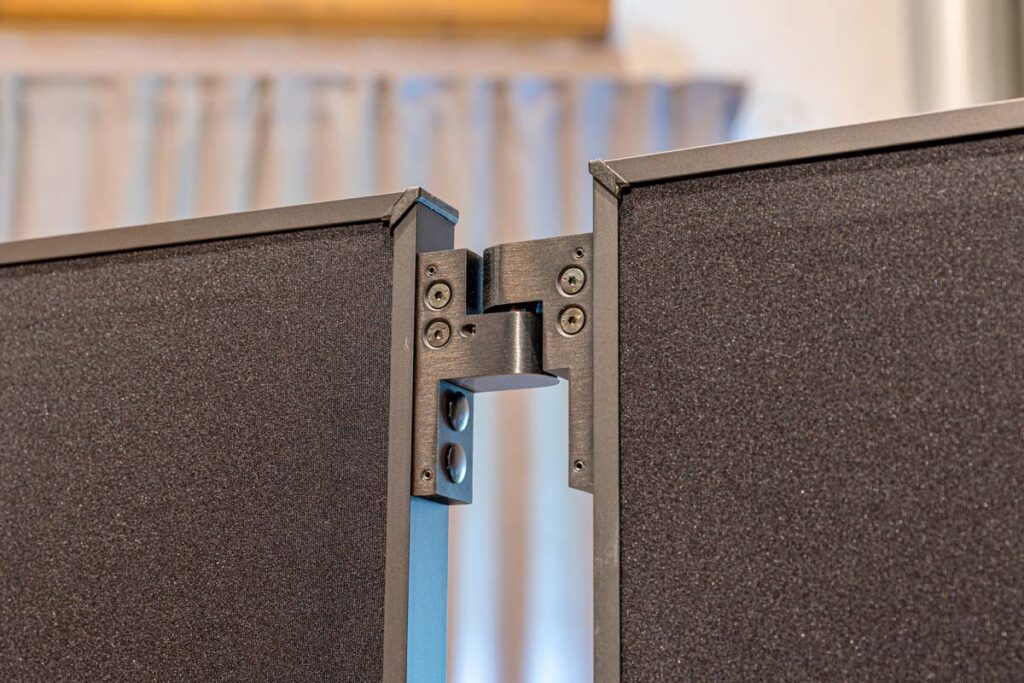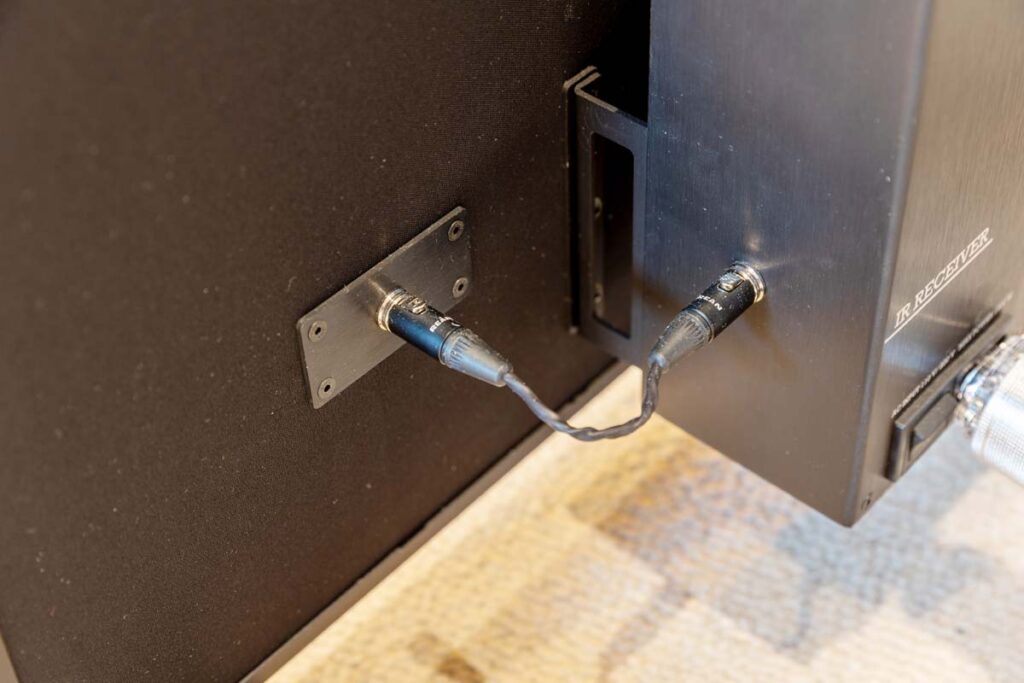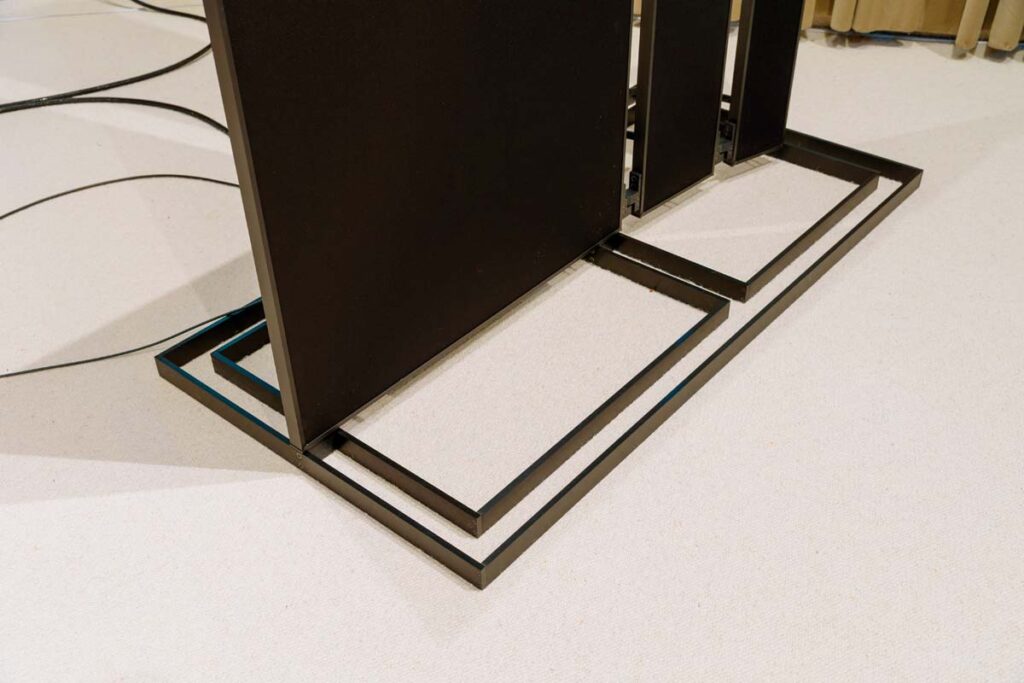Commit these terms to memory – and feel free to add your own. Should you ever take a detour to Fonica’s German distributor in Salzwedel, you’ll need this kind of vocabulary. By the bucketful.
My own “Tour de Fonica,” however, began with a moment of inner emptiness: in my hand I held my camera with its trusty 24-70 mm lens. Normally a solid choice for a “general overview.” The room before me, though, measured a stately 240 cubic meters, with monolithic, over two-meter-tall loudspeakers planted in the middle. I can’t even claim that the dimensions caught me off guard. My host, Andreas Launspach, a loyal FIDELITY reader, had sent us photos of his listening room years ago. If you flip back to the “Marktauftakt” (marketplace introduction page) section of FIDELITY 64, you’ll find one of his shots. But that fact is little comfort when you’re wishing for an ultra-wide-angle lens – the true dimensions of this miniature cathedral within the Villa Fonica don’t really come across even in his own photos.
First the room, then the house
The “acoustic study” reveals the trained businessman as both a connoisseur and a dogged hobby researcher. Andreas Launspach worked his way through the depths of room acoustics and designed his listening hall from first sketch to finished build – albeit with the support of an architect, who contributed expertise on things like structural integrity and integration. Together they managed to nestle the extraordinary listening salon so discreetly into a new-build home that no one would ever suspect the house was designed around a hi-fi room.
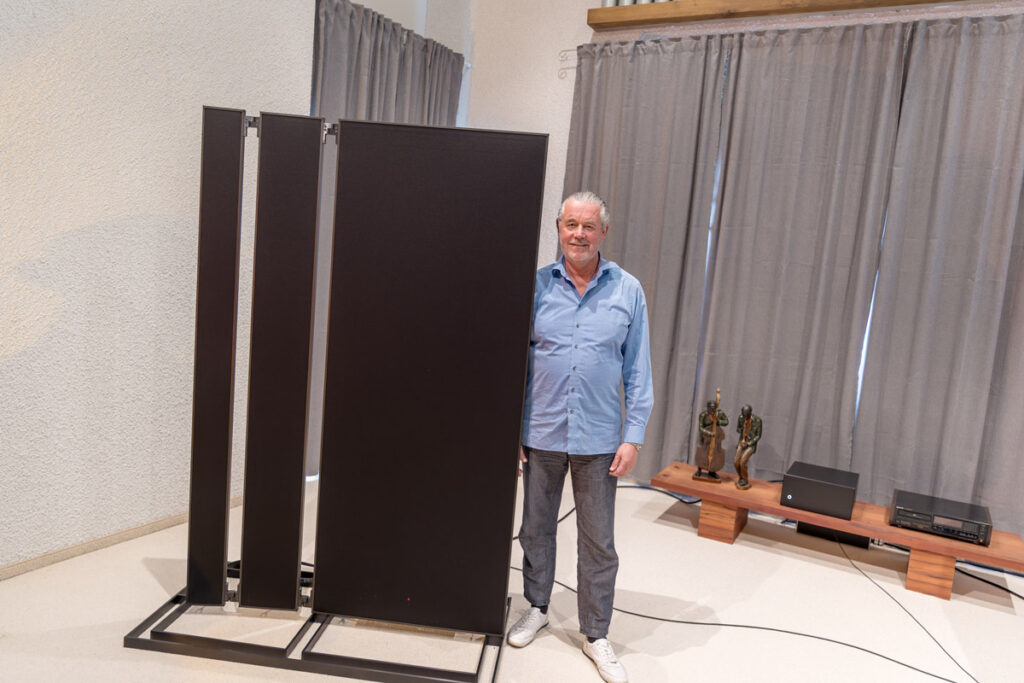
Walk into the upstairs space, and you first see a fairly ordinary ceiling – at 275 cm high, already reminiscent of the airy proportions of a Wilhelminian-era apartment. About two meters in, however, the ceiling opens up at an angle of nearly 45 degrees. At its highest point, it soars to a breathtaking 6.3 meters. If that’s hard to picture, just imagine a wedge of cake lying on its side.
To tame this “cheese wedge” acoustically, the homeowner went beyond basic measures like sound-absorbing carpets. He installed custom ceiling absorbers that cut unobtrusively across the length of the room, clad the walls in sound-dampening plaster, and built a hidden Helmholtz resonator over four meters tall into the masonry to the left of the hi-fi system. In the opposite corner stand three massive bass traps tuned precisely to the room’s modes. For higher frequencies, additional absorbers were needed. Launspach came up with the idea of painting pipes and arranging them on the wall behind the system like an organ – problem solved. The result of all this effort is a room with short, evenly distributed reverberation times, yet still lively enough to feel like a living space.
Off to Italy
And now to the real reason for my visit. Right in the center of the room stands a pair of LaGrande speakers from Fonica – huge planar magnetics with nearly three square meters of diaphragm area in total. Actually, it’s closer to six, but more on that in a moment. At my question how he’d come across these rather exotic Italians, Andreas Launspach smiled: years ago, he had stumbled on a short article on the FIDELITY website and had been hooked on the three-winged loudspeakers ever since.
I remembered: in spring 2018 we had indeed published a short report about a champagne reception where the then-distributor introduced the giants to invited guests. Launspach told me he had always loved the ruthlessly revealing openness and transparency of this type of speakers. But he was also a fan of punchy deep bass – and that’s where flat panel speakers typically fall short (more on that later). That’s why he had remained loyal to his fully active dynamic giants.
Last fall, while once again poring over the Italians’ homepage, curiosity finally got the better of him. After a phone call with Fonica, the Launspachs jumped in the car and combined a factory visit with a short vacation in idyllic Bergamo. The demo there dispelled any lingering doubts about the bass performance, and they hit it off so well with the manufacturer that during the visit itself the first thoughts of a “Villa Fonica” were already forming. Just weeks later, Launspach was not only the proud owner of a LaGrande but also Fonica’s German importer and distributor.
The LaGrande in his listening room is the fully active model. If you visited the HIGH END 2025, you might have seen its passive sibling in the shared Pathos/Fonica room. Each active speaker houses three Class-D amps from the acclaimed Hypex Ncore series: 500 watts each for bass and mids, 100 watts for treble. The manufacturer cites a frequency response of 25 Hz to 20 kHz.
There’s not one, but several reasons for the impressively deep bass foundation. For one, the ultralight diaphragms have evolved significantly. The bass driver – practically weightless at just a few grams – can handle serious excursions, moving up to 6 mm across its entire two-square-meter surface. That’s comparable to the excursion of conventional drivers, but here inertia and timing issues are virtually nonexistent.
Another key is Fonica’s special construction. As you may know, flat panel speakers are always dipoles, radiating sound out of phase front and back, which creates that expansive soundstage. The Italians wanted to preserve this advantage while boosting power. Their solution: mirrored diaphragms. Each of the six aluminum frames, only three centimeters deep, holds two drivers with their own magnet systems, working in opposite phase to the front and back – a dipole with double the muscle and headroom. Beyond that, the Italians remain tight-lipped about materials or diaphragm suspension.
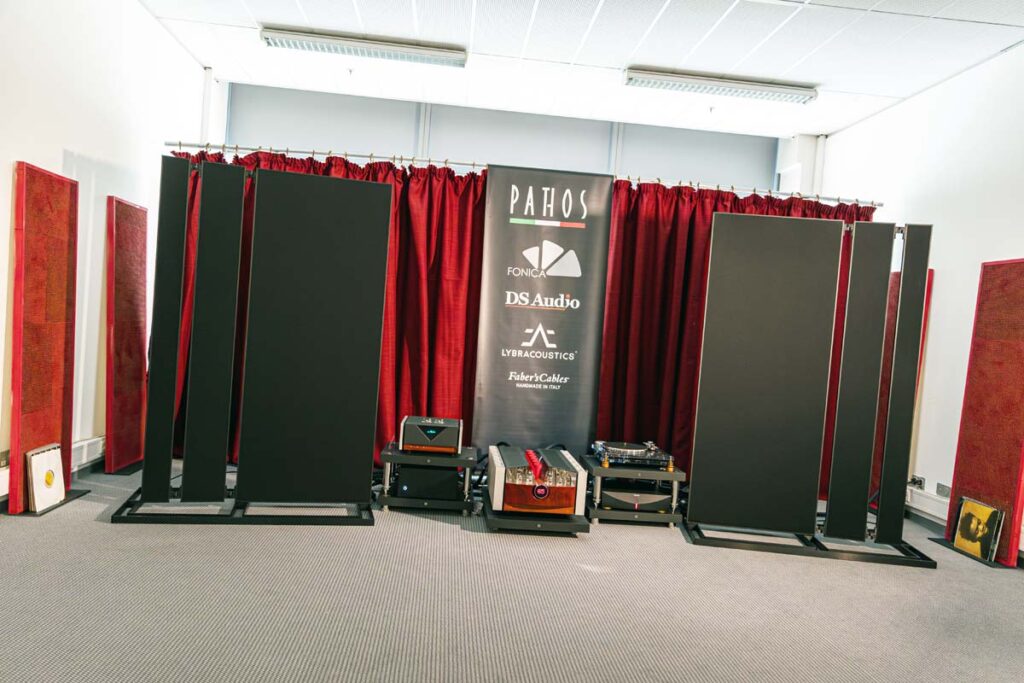
Digital brains handle integration: in addition to D/A converters (up to 24/192), each LaGrande includes a dedicated DSP to manage phase alignment of the Hypex modules and offer freely programmable EQ bands. These can correct for room acoustics and also provide tools for creating sound settings like a preset for late-night sessions at low volumes. Up to three presets can be stored and switched via the hefty metal remote. Still, the Italians are reluctant to rely solely on DSP trickery – hence the identical passive model.
Both versions share ultra-massive bases and decoupled “wings.” The broad feet are easily explained: they provide rock-solid stability and coupling to the floor. The three-panel construction is suspended on joints reminiscent of turntable bearings. The giant bass panels serve as the backbone; the two smaller frames are suspended from them with minimal contact. Dialing this in was less trivial than it sounds: for perfect imaging, the panels can be angled with millimeter precision toward the listening spot. The tricky part was keeping the listener from losing his mind because the slightest breeze would shift the panels around. This made locking mechanisms necessary, which needed to securely arrest the panels in their position while still retaining as little contact area as possible.
Earlier versions routed the cable bridges behind the top hinges – visually elegant, but they transmitted vibrations between panels. The current version routes them below, isolated from the speaker itself. The electronics, too, are decoupled: the black amplifier boxes are suspended a few centimeters off the speaker bases.
Showtime …
Once I’d digested all this information, I finally got to sit back and listen. With prior agreement, Launspach had prepared a playlist on his server. We began with two tracks from Michel Godard’s Monteverdi – A Trace of Grace. From the very first notes I was captivated by how the LaGrande dissolved the room’s boundaries, projecting an endless soundstage. Despite the cavernous reverb of the recording, every nuance of the instruments remained precise.
What I didn’t perceive were the speakers themselves. As if they were just pieces of furniture, they let the music bloom all around me but stubbornly refused to be associated with the sound. Many high-end speakers aspire to this, but the degree to which the LaGrande “disappears” requires listeners to adjust to a whole new level of detachment.
There was another aspect: my eyes kept darting to the corners, searching for a subwoofer – even though I knew better. Already with Mighty Sam McClain’s bluesy “Gone For Good”, the sound had more punch than I would have credited to a panel speaker. To prove the LaGrande could not only dig deep but also deliver lightning speed, Launspach followed with Charly Antonini’s “Duwadjuwandadu”. For ten minutes straight, snare, congas, cymbals, and finally a vibraphone whipped around the room, hurling sharp transients at me. “Zerop” by Ohm-G repeated the spectacular effect storm, this time diving one or two octaves lower with pure electronic force.
At last, it was time to check how the LaGrande handles timbre. Andreas Launspach had the answers ready: the compellingly showy third movement (Allegro Marcato) of Nelhýbel’s Trittico (Dallas Wind Symphony) and Stravinsky’s Firebird (Baltimore Symphony Orchestra) demonstrated that the midrange is vibrant and tonal hues are exactly the way they should be.
Taken together, the LaGrande’s performance is an experience that won’t let go of me anytime soon. If you’d like to find out for yourself: the distributor is happy to host private listening sessions. The excellent playlist is ready and waiting …
Flat Panel Speaker Fonica LaGrande
Concept: Three-way planar magnetic with integrated active electronics (passive version also available) | Construction: 3 decoupled aluminum frames with diaphragms for bass, mids, and treble | Amplification: 3 × Hypex Ncore modules per speaker (2 × 500 W bass & mids, 1 × 100 W treble) | Frequency response: 30 Hz – 20 kHz | Inputs: 2 × analog (RCA/XLR), 3 × digital (coax, optical, XLR) | D/A conversion: up to 24-bit/192 kHz | DSP: 3 programmable presets for different rooms/listening situations, switchable by remote | Accessories: integrated stand, metal remote | Finish: frames in black or natural aluminum, fabric in black or gray; custom fabrics (logos, etc.) available by request | Dimensions (W/H/D): 139/205/72 cm (including base) | Weight: 120 kg each | Warranty: 2 years | Price per pair: around €65,500
Villa Fonica – Andreas Launspach
Zum Buchhorst 33
29410 Salzwedel
Phone: +49 3901 304455 or +49 178 3105064
info@fonica-deutschland.com

